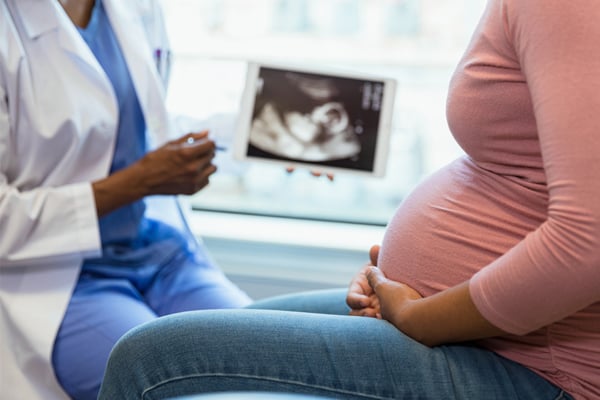Prime
Maternal sepsis is rare but it can be life-threatening

Receiving prenatal care and promptly seeking medical attention if symptoms arise can help reduce the risk of maternal sepsis. Photo | Gettyimages
What you need to know:
- Undetected and poorly managed infections can rapidly develop into sepsis, resulting in death or disability for the mother, increased risk of neonatal infections, and other adverse effects.
Allen Nakuya underwent a cesarean birth for her second baby because the baby was in an abnormal position. After the operation, both mother and baby were fine, but the doctors decided not to discharge her until after a week.
When she returned home, she noticed her wound was healing poorly, and the skin around the surgical area was pale and felt hot to the touch.
"I called the doctor who advised me to come back as soon as possible. Upon my return, I was readmitted, and the doctor said my wound had become septic. It had to be scraped to remove some of the inflamed tissue," she recalls.
Nakuya spent an additional two weeks in the hospital. If she had not sought medical attention early, she could have developed complications or even died.
Infection
Maternal sepsis is a life-threatening condition that occurs when the body's response to infection causes harm to its tissues and organs during pregnancy, childbirth, post-abortion, or the postpartum period.
Dr Joel Lwasa, an obstetrician/gynecologist at Kawempe National Referral Hospital, says this health issue is the third leading cause of maternal mortality in Uganda. Undetected and poorly managed infections can rapidly develop into sepsis, resulting in death or disability for the mother, increased risk of neonatal infections, and other adverse effects.
“Pregnancy-related maternal sepsis can develop in mothers who are pregnant, have recently delivered a baby, have had a cesarean or natural birth, or have experienced a spontaneous abortion,” he says.
It typically begins as a simple infection from any source, and the body is expected to heal on its own. However, the immune system can become overwhelmed, leading to dysfunction in the system where the infection originated.
Prevalence
The World Health Organisation (WHO) estimates that this global concern contributes to about 10 percent of preventable maternal deaths in developing countries. According to the Uganda National Institute of Public Health, there were 16,654 new admissions due to maternal sepsis reported from 2013 to 2017. The annual maternal sepsis admissions rate at health facilities in Uganda increased gradually from 28 per 1,000 live births in 2013 to 50 per 1,000 live births in 2017. Sepsis complicates about five percent of live births and nearly 15 percent of the women affected by it come close to death.
In a 2016 study published in BMC Pregnancy and Childbirth, it was found that puerperal sepsis accounted for 30.9 percent of maternal deaths in Mbarara Regional Referral Hospital. This was followed by obstetric hemorrhage (21.6 percent), hypertensive disorders in pregnancy (14.4 percent), abortion complications (10.8 percent), and malaria (8.92 percent).
The 2022 Uganda Demographic Health Survey reported a reduction in the Maternal Mortality Ratio from 336 to 189 per 100,000 live births. However, the Sustainable Development Goal (SDG) targets aim to decrease Maternal Mortality Ratios to 70 per 100,000 live births.
Risk factors
During pregnancy, women are at risk of sepsis because it dampens their immune system, Dr Lwasa says. As pregnancy progresses, the uterus enlarges and compresses the bladder, making it impossible to empty the bladder. The remaining urine becomes a breeding ground for bacteria, leading to urinary tract infections (UTIs).
During pregnancy, the pressure on the diaphragm can make coughing and expelling phlegm difficult, increasing the risk of pneumonia. Gestational diabetes also raises the risk of sepsis.
During labour, rupture of the membranes, vaginal examinations, C-section births, and manual removal of the placenta increase a woman's risk of sepsis.
“Maternal sepsis can result from various infections, such as urinary tract infections, pneumonia, infections related to abortion or miscarriage, infections following cesarean section or other surgical interventions, and infections related to premature rupture of membranes,” says Dr. Lwasa.
Factors associated with maternal mortality include lack of education, HIV-positive status, lack of antenatal care attendance, rural residence, and delays in seeking healthcare.

The commonest signs and symptoms of sepsis include difficulty breathing, fever or low temperature and shivering, confusion, extreme body pain or discomfort, clammy and sweaty skin, high heart rate, weak pulse or low blood pressure, low urine output, hot reddened area, pain and swelling, pus discharge and poor wound healing especially those who have undergone a C-section birth.
Managing sepsis
Early detection and treatment are crucial for improving patient outcomes. Pregnant women are at a higher risk of developing sepsis due to natural immunological changes during pregnancy. Practicing good hygiene, receiving appropriate prenatal care, and promptly seeking medical attention if symptoms arise can help reduce the risk of maternal sepsis.
Dr Lwasa says proper hygiene techniques such as handwashing and sanitizing with alcohol-based sanitizer can reduce up to 50 percent of infections.
“Use of safe delivery practices, delivering mothers in a sanitary environment, identifying and treating infection promptly using the appropriate antibiotics could all help reduce the risk of infections,” he says.
To combat sepsis, there is an ongoing effort to implement an action plan for maternal sepsis real-time surveillance in Uganda (2021-2026). The plan aims to develop capacity for prompt detection and treatment of sepsis among maternal care receivers, reducing maternal deaths.
Challenges
Dr Joel Lwasa, an obstetrician/gynecologist at Kawempe National Referral Hospital, emphasises the importance of addressing conditions such as severe bleeding, which can be rapidly fatal. Surgical interventions can be crucial in saving the lives of mothers suffering from severe sepsis.
In rural areas, many people have primitive methods of managing infections, such as using cow dung. Some believe it is due to witchcraft, while others delay seeking medical help and rely on traditional birth attendants. By the time they come to the hospital, it is often too late. Some individuals die on the way, especially those who live far from hospitals.
The decision-making power often associated with males and their financial dependency can hinder timely health intervention for women, as they may have to wait for their husbands to make decisions before seeking medical care. Additionally, there is a common misconception that antibiotics can treat all infections, leading many people to engage in self-medication.




